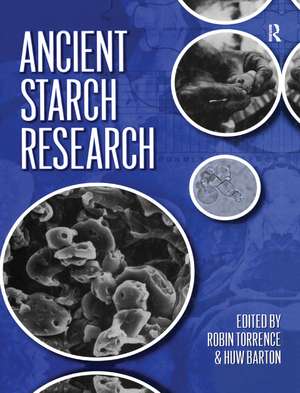Ancient Starch Research
Editat de Robin Torrence, Huw Bartonen Limba Engleză Paperback – 30 iun 2020
Preț: 288.80 lei
Nou
Puncte Express: 433
Preț estimativ în valută:
55.26€ • 57.84$ • 45.100£
55.26€ • 57.84$ • 45.100£
Carte disponibilă
Livrare economică 10-24 martie
Livrare express 22-28 februarie pentru 32.66 lei
Preluare comenzi: 021 569.72.76
Specificații
ISBN-13: 9780367605780
ISBN-10: 0367605783
Pagini: 272
Dimensiuni: 210 x 280 x 15 mm
Greutate: 0.45 kg
Ediția:1
Editura: Taylor & Francis
Colecția Routledge
Locul publicării:Oxford, United Kingdom
ISBN-10: 0367605783
Pagini: 272
Dimensiuni: 210 x 280 x 15 mm
Greutate: 0.45 kg
Ediția:1
Editura: Taylor & Francis
Colecția Routledge
Locul publicării:Oxford, United Kingdom
Cuprins
Ancient Starch Research
Recenzii
This book furnishes a methodological and conceptual framework to researchers, scholars, students, and professors interested in starch and starch plant sources. We enjoyed reading it and strongly recommend it as a tool... -Concepcion Obon and Diego Rivera, Economic Botany
"For palynologists who work with archaeologists and even those working outside archaeology but in Holocene deposits, this book is essential.... Palynologists need to know the potentials of starch research, need to know how it can be recovered, need to know the types of information it might provide, and need to be alert about the potentials in order to recommend searching for 'both fossil pollen and starch grains' in ancient sediments." -Vaughn M. Bryant, American Association of Stratigraphi Palynologists Newsletter
"This book is a collaborative effort brought together over several years by a group of scholars, primarily archaeologists and particularly based in Austalia. They wished to emphasize the importance and potential contributions of ancient starch research, and to produce a basic textbook on how this reasearch is currently being undertaken and the challenges the field faces. They were not seeking to produce a definitive 'how-to' guide, but rather sought to treat methods comprehensively while at the same time presenting numerous case studies, experiments, and new ideas. They have succeeded admirably.... The writing is very easy to follow, whatever the background of the reader, yet still conveys the more technical information needed to understand and appreciate the meaning of starch granule form. The text flows very well from chapter to chapter, despite the multiplicity of authors, and I always found it enjoyable and easy to return to as I read on.... Ancient Starch Research is essential for any researcher engaged in ancient starch rsearch, any student who is thinking about working in this area, and anyone who wants to understand the basis for interpretation in this field in terms of strengths, weaknesses, methods, and potential. It is an outstanding book and I recommend it most highly." -Brian Kooyman, Journal of California and Great Basin Anthropology
"For palynologists who work with archaeologists and even those working outside archaeology but in Holocene deposits, this book is essential.... Palynologists need to know the potentials of starch research, need to know how it can be recovered, need to know the types of information it might provide, and need to be alert about the potentials in order to recommend searching for 'both fossil pollen and starch grains' in ancient sediments." -Vaughn M. Bryant, American Association of Stratigraphi Palynologists Newsletter
"This book is a collaborative effort brought together over several years by a group of scholars, primarily archaeologists and particularly based in Austalia. They wished to emphasize the importance and potential contributions of ancient starch research, and to produce a basic textbook on how this reasearch is currently being undertaken and the challenges the field faces. They were not seeking to produce a definitive 'how-to' guide, but rather sought to treat methods comprehensively while at the same time presenting numerous case studies, experiments, and new ideas. They have succeeded admirably.... The writing is very easy to follow, whatever the background of the reader, yet still conveys the more technical information needed to understand and appreciate the meaning of starch granule form. The text flows very well from chapter to chapter, despite the multiplicity of authors, and I always found it enjoyable and easy to return to as I read on.... Ancient Starch Research is essential for any researcher engaged in ancient starch rsearch, any student who is thinking about working in this area, and anyone who wants to understand the basis for interpretation in this field in terms of strengths, weaknesses, methods, and potential. It is an outstanding book and I recommend it most highly." -Brian Kooyman, Journal of California and Great Basin Anthropology
Descriere
This book describes the fundamental principles and methods of using ancient starch molecules to elicit plant use, environmental conditions, and social relations in the ancient world.
